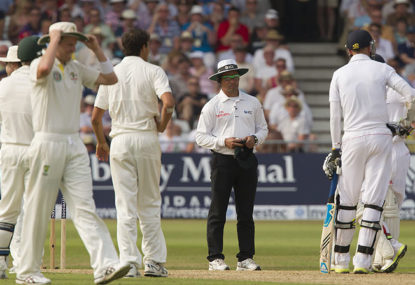Cricket Australia backflips on Bartlett's county stint, Stoinis slams century to break IPL drought
Xavier Bartlett has been permission to extend his cricketing education with a spell of T20s in England, playing in the Blast competition for Kent…

The move towards technology as an aid in officiating in various sports has been widespread in recent times.
Its aim, presumably, is to prevent match altering incorrect decisions and to provide accuracy in officiating. In reality however, the use of video review systems have proven to not be foolproof, as evidenced by a few examples recently.
The apparent no try to Penrith Panthers winger, Dean Whare that was awarded as a try, highlights that having a video review system does not guarantee accuracy.
Similarly, the Stuart Broad non-dismissal in the first Ashes test, which was a clear umpiring error, showed the shortcomings of the Decision Review System (DRS).
In this case, despite technology being available to remedy the umpiring howler, this was not possible as Australia had used all their available challenges for the innings.
Most sports nowadays have some type of referral system.
In tennis, the hawk-eye challenge system is used at all four Grand Slams and most ATP and WTA tournaments.
Typically this system allows players three incorrect challenges per set, with this number increased if the set is extended.
However, this referral system also has its apparent shortcomings.
Namely, the technology is generally not available on all courts, meaning that some players will be playing matches under the challenge system whereas others will not, depending on which court they are rostered to play on.
Also, given the number of incorrect challenges afforded to players, more frequently the system is being abused by players who are attempting to alter the momentum of a match.
Roger Federer has openly admitted to using challenges out of frustration or to slow the pace of play after a lengthy point. This is surely not what the system was designed to achieve.
The AFL has also moved towards goal review technology.
After a lengthy consultation between on-field umpires, boundary umpires and the goal umpire a decision may be referred to a video umpire who will analyse all available camera angles and either confirm or alter the original on-field decision.
The absurdity of this process, is that on the majority of occasions the vision proves to be inconclusive and the original decision stands.
The goal umpires sole responsibility is to watch the ball go through the goalposts, surely they are the one in the best position to make an accurate decision.
The DRS system used in cricket, enables a third umpire to utilise all available technologies to determine whether a decision is correct or not.
A major constraint of DRS is that not all technology can be used by the third umpire.
For example, the “snicko” technology cannot be used, rather is only a viewing aid.
Players can use DRS in the hope of uncovering a no ball and surviving an otherwise legitimate dismissal.
Once again what is the purpose of having an on-field umpire if not to make those decisions.
FIFA have moved to introduce goal-line technology and many other sports currently use some form of review system in the officiating process. The question needs to be asked as to what end technology will be used to make decisions in a variety of sports.
The poor umpiring or refereeing decision has always been a part of sport.
You get the good and you get the bad decisions and this adds to the theatre of sport.
Why then would you move in such a direction to eliminate this theatre, when these review systems have been shown to have numerous problems across many sports?
Still, as sport becomes more professional, sporting organisations will undoubtedly look to utilise more technologies to aid in officiating.
One day we may get to a point where all decisions are made by someone sitting at a desk staring at a bunch of televisions, making on-field officials obsolete and sport would be far the worse for it.